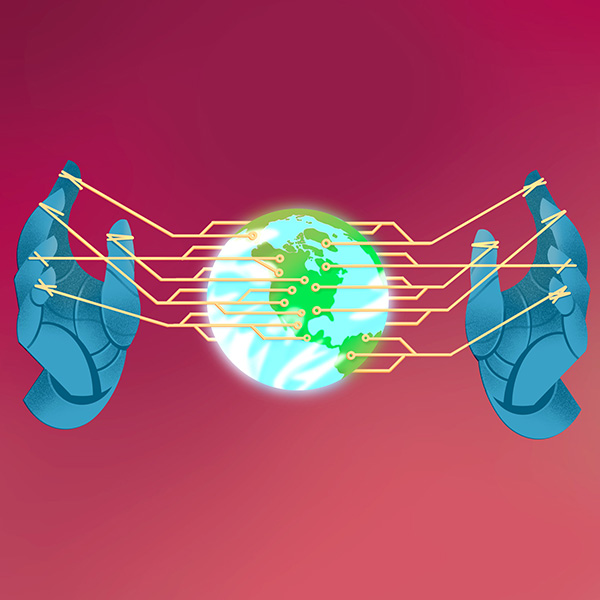Did life exist on Mars about 3.7 billion years ago?
Telecom systems engineer Peter Ilott, BSc’80, PhD’88, has been part of four successive NASA rover missions to the red planet. Each one brings us closer and closer to an answer.
“It would be incredible if our Perseverance rover drove up and found an ancient microbial fossil in the Jezero Crater,” says Ilott, a senior member of NASA’s Jet Propulsion Lab (JPL) in Pasadena, California, who guided the telecom team as Perseverance nailed its landing onto a smooth area in hazardous Martian terrain on February 18.
Incredible, but not impossible.
Ilott worked on NASA’s Spirit and Opportunity rover missions to the surface of Mars in 2004, which found ample evidence that water once flowed there. He was also lead telecom systems engineer for NASA’s clever and durable Curiosity rover in 2012, which is still actively gathering and transmitting data an average distance of 225 million kilometres (140 million miles) through interplanetary space to radio antennae on Earth.
Curiosity discovered new evidence the planet could have supported life by identifying organic compounds preserved in sedimentary rocks that formed a vast ancient lakebed and by detecting seasonal variations in methane in the Martian atmosphere.
Now, the more sophisticated Perseverance rover will gather and analyze exposed cliffside rocks in a former river delta to search for traces of extinct microbial life. And, in anticipation of future manned space missions, a device called MOXIE (Mars Oxygen In-Situ Resource Utilization Experiment) will try to convert carbon dioxide from the Martian atmosphere into oxygen for humans to breathe and produce rocket fuel for a return trip to Earth.
“I think it would be really cool to have a manned mission to Mars – though it will be very expensive. I always wanted to be an astronaut. If there was a guarantee I could get back safely, I’d go,” muses Ilott. He will be overseeing telecommunications for the Europa Clipper spacecraft on a more distant mission to Jupiter’s moon Europa, set to launch in 2024 and arrive in 2030.
On the current mission, Ilott is in charge of relaying telecommunications signals and data from Perseverance to Earth, and uplinking or sending commands to the solar-powered rover each morning to carry out and complete its tasks during the Martian day, known as “sol.”
As Perseverance began its descent towards the target zone inside the Jezero Crater last month, Ilott was in a cruise-mission support room at JPL, listening to telecom signals in near real-time to confirm the health of the spacecraft and its precise location. “The prime responsibility for the telecom systems team during landing is to gather enough information to relay or communicate what happened if something goes wrong. In practice runs, people throw problems at us to test solutions if the signals go awry,” he explains.
Ilott was especially eager to hear signals indicating that the new Terrain-Relative Navigation (TRN) system, which autonomously guides the rover to avoid hazards, was functioning properly. “When I heard the TRN was recognizing the terrain, I started to feel more and more confident. We knew the spacecraft was still healthy because we were getting data from it. That’s when my brain started to allow myself to get excited. If I get excited too early, I can’t concentrate on my job,” says Ilott, who was recently promoted to assistant division manager for flight projects, JPL Communications, Tracking & Radar Division.
Since the landing, Ilott has been uplinking commands to Perseverance to begin performing its daily tasks at 9 am Mars time, a shift that starts 40 minutes later each day in California since Martian days are 40 minutes longer. These early tasks ranged from testing a two-metre robotic arm that will drill and collect core samples of Mars rock and dust to rover venturing on its first 33-minute test drive in early March. “We’re looking forward to deploying the Ingenuity helicopter for an initial test flight, possibly in the first 30 days,” he says.
When Ilott joined JPL in 2000 after working for 12 years in the commercial spacecraft industry, the odds of sticking a rover landing on Mars were even more formidable than today. Two NASA missions to Mars had failed in 1999 when its Climate Orbiter burned up in the atmosphere and the Polar Lander failed to fire during its descent.
“It was intimidating and a trial by fire. We worked our butts off to make the Spirit and Opportunity landings a success,” says Ilott, who has since helped many other space projects flourish, including Deep Impact, where NASA crashed a projectile into a comet, and the Deep Space Network, which supports more than 30 NASA and international robotic space missions.
Ilott’s trajectory into deep space exploration got an initial boost, shortly after he began studying physics at McGill in the fall of 1977, through a prescient encounter with a visiting JPL scientist.
“I was a student in physics learning all about the universe. A month after I started at McGill, a fellow from JPL talked to us about NASA’s Voyageur mission, which had just launched twin spacecraft. He said in the next two and three years, Voyageur 1 and 2 would be flying by Jupiter and Saturn, taking pictures of Saturn’s rings, and they would eventually fly by Neptune and Uranus. We were blown away and it sure had an impact,” recalls Ilott.
The Voyageur mission has continued and is now exploring interstellar space, the region between the stars, and the two spacecraft are sending scientific information to Earth through the Deep Space Network. “It’s amazing that Voyageur is still going 44 years later, which spans my entire career in university and the space business,” he says.
Ilott’s grounding in physics has had a lasting impact too. While his specialized PhD training in electrical engineering and telecommunications has been very useful throughout his career, Ilott believes his physics background and mindset are mission-critical. “Physics helps me understand problems quicker, better and in more depth. It’s hard to find an aspect of physics that doesn’t apply to these missions,” he says.
His next interplanetary mission to Jupiter’s icy moon Europa will be another astrobiological quest. “We’ll be trying to verify that there is a subsurface ocean beneath the ice and determine if life could have developed in places in the deepest ocean where there is no sunlight,” says Ilott, whose boyish enthusiasm and thirst for space exploration is undiminished.
“I’ve been lucky to get to work on all these planetary missions. They’re fun and very exciting. I also got into amateur astronomy lately. When I take my telescope out and look at Mars, I think about the hardware I’ve developed, touched and held in my hands that will be there for millions of years,” he says.


